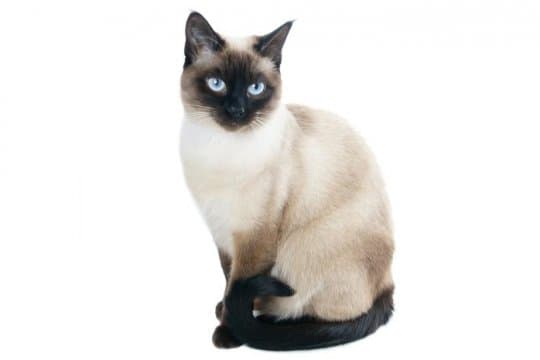
thai-old-style-siamese
Extroverted, vocal, affectionate, inquisitive
Overview
Origin
Thailand
Life Span
12-16 years
Height
21"- 23"
Weight
10-16 pounds
Group
Large long-haired
Price
$600 - $1200
History
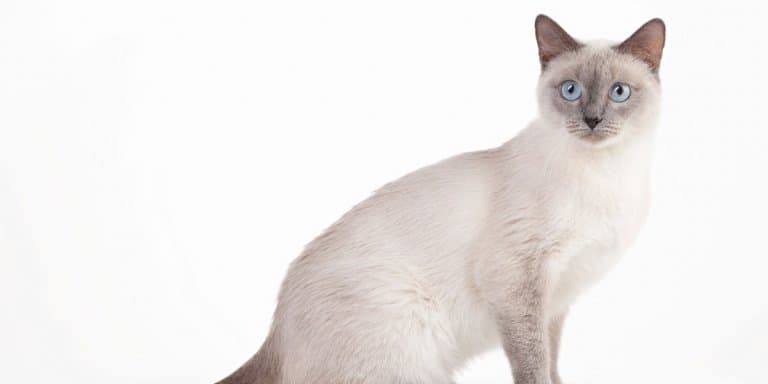
Thai cats, also known as old-style Siamese cats or traditional Siamese cats, are bred with the intention of maintaining the characteristics of Thailand’s indigenous pointed cats, also known as the wichienmaat, or "moon diamond" cats of ancient Siam.
A pair of Thai cats—also known as royal cats from Siam—were presented to England’s royal family in 1886. Over time, more Siamese were imported and the breed gained popularity not just in England, but across the pond, in America.
The distinction between the old-style Siamese and the modern Siamese began during the 1950s, when some breeders were selecting for old-fashioned characteristics and others were aiming for the longer, thinner, more angular features seen in contemporary show Siamese.
Preservation of the old-style Siamese cat began in earnest during the 1980s, as breed clubs were formed in Europe and the United States. In 2001, some breeders increased their efforts, importing indigenous pointed cats directly from Thailand.
The imported cats help achieve two goals. First, they widen and improve the Thai breed pool. Second, they help preserve Southeast Asia’s native cat breed, separating indigenous eastern cats from their western counterparts.
In 1990, the World Cat Foundation (WFC) granted the Thai cat full championship competitive status as a separate breed. The independent cat club Prestwick-Beresford Old-Style Siamese Association (PREOSSIA) is credited with coining the name old-style Siamese in 1999. The Old-Style Siamese Club (OSSC) adopted the same name in 2000.
PREOSSIA set the new breed application process in motion with The International Cat Association (TICA). In 2007, TICA decided against granting old-style Siamese separate breed status, and breeders decided to use the name “Thai” rather than old-style Siamese. In 2010, the Thai cat was granted championship status by TICA.
Federation Internationale Feline (FIFe), and Feline Federation Europe recognize Thai cats, as well.
Today, you can easily tell the difference between a Thai cat or old-style Siamese and a modern Western Siamese (sometimes called wedgehead Siamese). Thai cats are larger, rounder, and generally more robust in appearance than their contemporary cousins.
Care
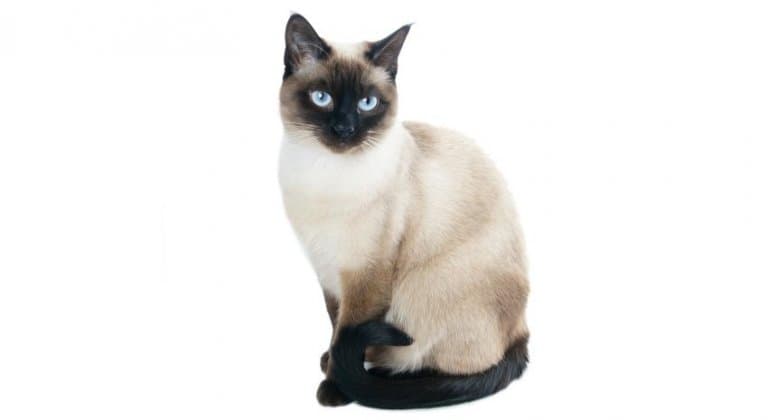
Nutrition
Thai cats cats have no special nutritional needs. However, like all cats, Thai cats thrive on high-protein, low-carbohydrate diets. Choose a food that incorporates real meat or fish as the main ingredient, as excess carbohydrates can contribute to obesity, particularly later in life. Be sure to feed your cat appropriately for its age.
Grooming
Give your cat a quick once-over with a soft brush or offer a brisk rub with your fingertips a few times per week to remove dead hair that might otherwise end up on your clothing and furniture. You can bring out the shine in your cat’s coat by following up with a quick polish, using a soft silk scarf or a chamois.
Exercise
You won’t have to encourage your Thai cat to play! They love to zoom up and down their cat trees, and they truly enjoy stretching on a scratching post. Two more pastimes they enjoy include jumping up into windows and hiding in wait for another cat to pass—and then leaping out in a surprise attack. With lots of interaction and plenty of toys, you can satisfy your cat’s need to expend energy and be entertained by their antics in the process.
Health
Thai cats are generally robust and healthy, however they can occasionally suffer from heart disease, gangliosidosis, hyperesthesia syndrome, psychogenic alopecia, and respiratory infections.
Breed Standard
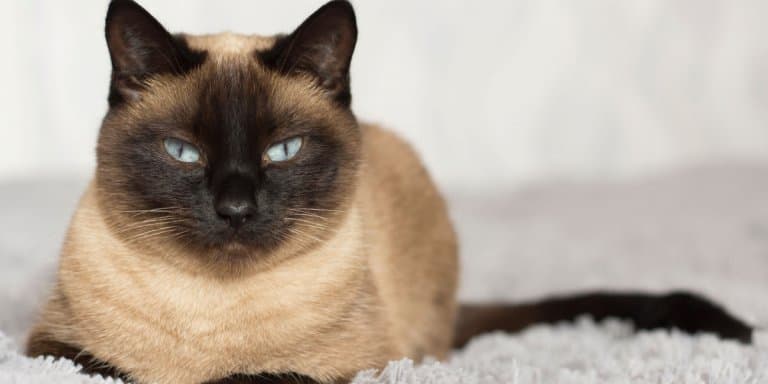
Body
The body is graceful and lithe, but not tubular or too compact. Overall, the cat ismedium to large, with no extremes. The Thai cat does not resemble a native Western cat breed, nor does it have the appearance of a contemporary or modern Siamese.
Head
The Thai cat’s head is a modified wedge of medium width, longer than it is wide, but neither narrow nor extreme. The muzzle is wedge-shaped, and the upper portion of the head is laterally rounded. The nose is nearly straight, with a gentle, convex curve above the eyes and a gradual concave curve beneath the eyes when viewed in profile. The neck is of medium length, and not too narrow.
Eyes
The Thai cat has blue eyes. In show cats, deeper colors and greater brilliance are preferred characteristics.
Ears
The Thai cat’s ears are medium to large, with wide bases and oval tips, set closer to the top of the head than to the head’s sides. The inner base of the ear is set above the center of the corresponding eye. Light furnishings are permitted.
Color
Thai cats have pale, off-white bodies. The points are dense and even, with the mask, ears, feet, and tail matching. Seal, blue, lilac, and chocolate colors are common and some standards accept red, flame, and lynx point colors as well.
Coat
The coat is short to very short in length, with a silky texture and little to no undercoat. The coat lies very close to the body, but does not have to appear “painted on.”
Tail
The tail is long and gently tapered, but not whippy. It is the same length as the cat’s torso.
Legs & Paws
The legs are of medium length, with a graceful appearance. The feet are of medium size, in good proportion to the cat’s overall size, and have an oval shape.
Personality & Temperament
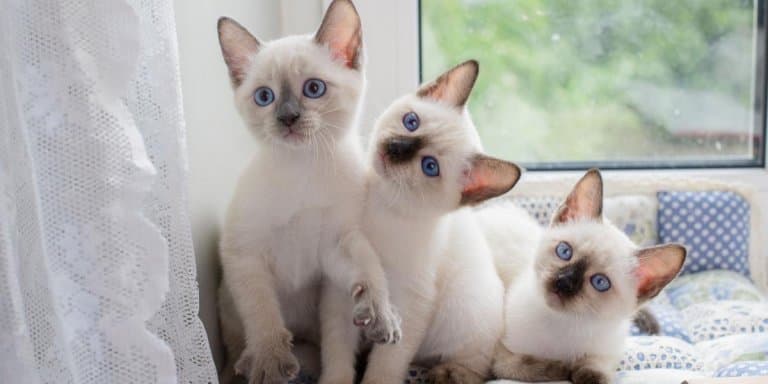
Thai cats—also known as old-style Siamese cats or traditional Siamese—are charming companions with beautiful features and playful, inquisitive personalities. Just like their western Siamese cousins, Thai cats love everyone, including kids, other cats, and cat-friendly dogs. In fact, they’re so affectionate and social, they hate to spend time on their own.
Intelligent and curious, Thai cats are capable of learning tricks, particularly when rewards are on offer. Whether you’d like your cat to come when you call their name or use another signal, or if you’d like to enjoy rousing games of fetch, the Thai cat will be glad to oblige.
If you bring a Thai cat into your family, you’ll want to do everything you can to prevent boredom. These cats need companionship and acceptable activities, or they’ll find their own fun, reaching into cupboards, opening drawers and investigating their contents, and perhaps learning how to open doors and turn on faucets. Thanks to their determined personalities, there’s little that a Thai cat can’t learn! Channel their behavior into puzzle toys and give them another cat for a friend, and you’ll find that life is a bit less chaotic.
Bouts of mischievous behavior are sure to put a smile on your face, even when your cat is splashing in your bath or trying to help you clean up after dinner. But old-style Siamese are capable of deep relaxation. When you settle in for a movie or snuggle into bed at night, they like to cuddle close, purring the entire time.
Talkative and truly endearing, with big personalities that are difficult to resist, Thai cats make astonishing pets for families with time and attention to share.